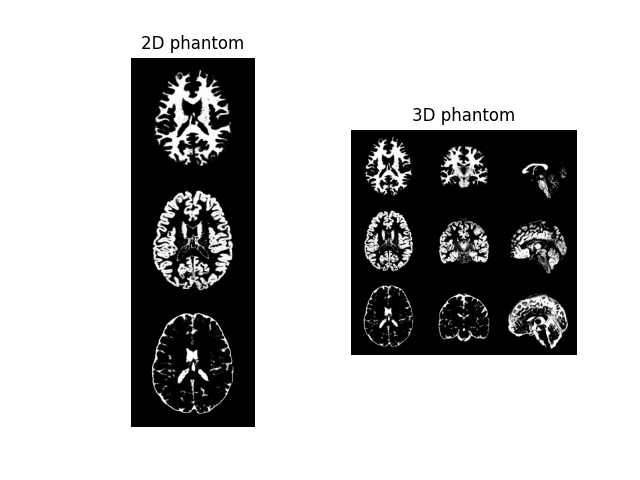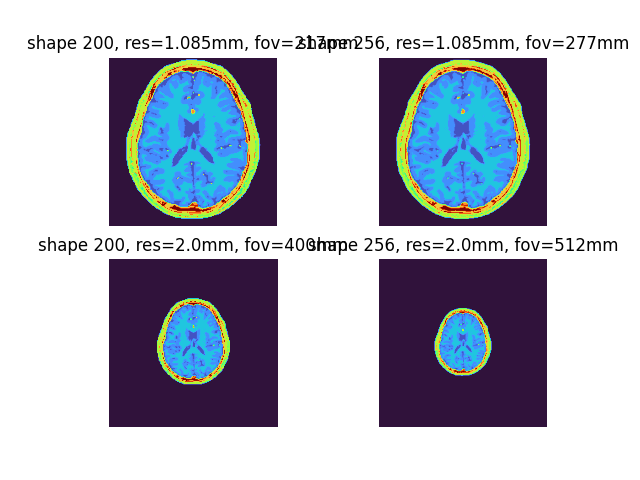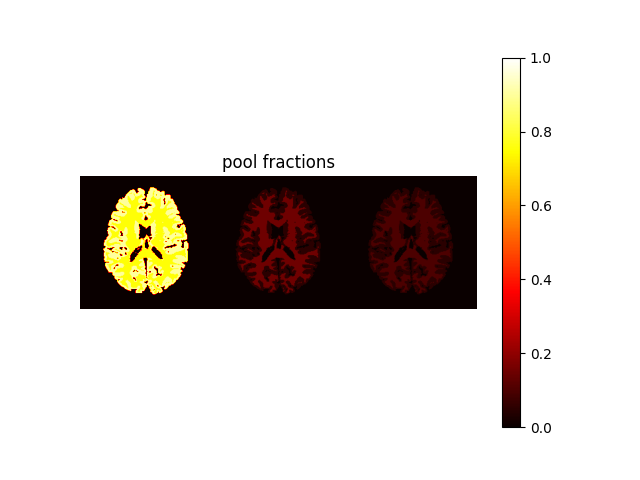Note
Go to the end to download the full example code. or to run this example in your browser via Binder
Brainweb Phantom#
Example of Brainweb phantom creation.
This examples show how to generate numerical phantoms based on the Brainweb dataset.
import matplotlib.pyplot as plt
import numpy as np
from mrtwin import brainweb_phantom
Basic Usage#
The Brainweb database consists of a set of 20 normal brains
(ids equal to [4, 5, 6, 18, 20, 38, 41-54]) at a nominal 0.5 mm isotropic
resolution and a shape of (nz, ny, nx) = (362, 434, 362).
A digital Brainweb phantom can be created as:
phantom2D = brainweb_phantom(ndim=2, subject=4, segtype="fuzzy") # 2D phantom
phantom3D = brainweb_phantom(ndim=3, subject=4, segtype="fuzzy") # 3D phantom
The phantoms here created are sparse, i.e., they consists of a
(nclasses, *spatial_shape) shaped np.ndarray representing the
probabilistic maps of each tissue type (e.g., Gray Matter, White Matter, CSF)
and a list of (nclasses,) dictionaries each containing the (M0, T1, T2, T2*, Chi)
values for each class:
example2D = np.concatenate((phantom2D[3], phantom2D[2], phantom2D[1]), axis=0)
example3Dax = np.concatenate(
(phantom3D[3, 100], phantom3D[2, 100], phantom3D[1, 100]), axis=0
)
example3Dcor = np.concatenate(
(phantom3D[3, ::-1, 100], phantom3D[2, ::-1, 100], phantom3D[1, ::-1, 100]), axis=0
)
example3Dsag = np.concatenate(
(
phantom3D[3, ::-1, :, 100],
phantom3D[2, ::-1, :, 100],
phantom3D[1, ::-1, :, 100],
),
axis=0,
)
example3D = np.concatenate((example3Dax, example3Dcor, example3Dsag), axis=1)
fig1, ax1 = plt.subplots(1, 2)
ax1[0].imshow(example2D, cmap="gray"), ax1[0].axis("off"), ax1[0].set_title(
"2D phantom"
)
ax1[1].imshow(example3D, cmap="gray"), ax1[1].axis("off"), ax1[1].set_title(
"3D phantom"
)
plt.show()

The (M0, T1, T2, T2*, Chi) properties
can be direcly accessed as:
M0: [0. 1. 0.86 0.77 1. 1. 1. 1. 1. 1. 1. 1. ]
T1 (ms): [ 0. 4200. 998.1393 680.66815 342.50705 1050.
1050. 350. 1549.5471 342.50705 700. 552.36127]
T2 (ms): [ 0. 1990. 100. 80. 70. 50. 50. 15. 200. 70. 150. 50.]
T2* (ms): [ 0. 243.06877 73.46702 62.067276 64.09466 42.323383
42.323383 14.274805 116.12312 64.09466 97.293144 46.912655]
Chi: [ 4.00e-07 -9.00e-06 -9.00e-06 -9.00e-06 3.28e-06 -9.04e-06 -9.04e-06
-8.44e-06 -9.00e-06 3.28e-06 -9.00e-06 3.28e-06]
If required, the properties dictionary
can be directly accessed as:
print(phantom2D.properties)
{'M0': array([0. , 1. , 0.86, 0.77, 1. , 1. , 1. , 1. , 1. , 1. , 1. ,
1. ], dtype=float32), 'T1': array([ 0. , 4200. , 998.1393 , 680.66815, 342.50705,
1050. , 1050. , 350. , 1549.5471 , 342.50705,
700. , 552.36127], dtype=float32), 'T2': array([ 0., 1990., 100., 80., 70., 50., 50., 15., 200.,
70., 150., 50.], dtype=float32), 'T2s': array([ 0. , 243.06877 , 73.46702 , 62.067276, 64.09466 ,
42.323383, 42.323383, 14.274805, 116.12312 , 64.09466 ,
97.293144, 46.912655], dtype=float32), 'Chi': array([ 4.00e-07, -9.00e-06, -9.00e-06, -9.00e-06, 3.28e-06, -9.04e-06,
-9.04e-06, -8.44e-06, -9.00e-06, 3.28e-06, -9.00e-06, 3.28e-06],
dtype=float32)}
e.g., to be passed as **kwargs to a simulator routine.
Notice that segmentation can be accessed directly (in read-only mode) via square bracked indexing, similarly to numpy arrays.
A basic summary of the properties can be accessed
via the __repr__ attribute (i.e., enabling pretty printing):
print(phantom2D)
print(phantom3D)
# We also provide a crisp segmentation, which has a lower memory footprint
# at cost of a coarser approximation (i.e., a piecewise-constant tissue model)-
#
# This can be obtained starting from the `"fuzzy"` phantom as:
phantom2D = phantom2D.as_crisp()
phantom3D = phantom3D.as_crisp()
# Print summary
print(phantom2D)
print(phantom3D)
# Display spatial segmentations
example2D = phantom2D
example3Dax = np.concatenate((phantom3D[100], phantom3D[100], phantom3D[100]), axis=0)
example3Dcor = np.concatenate(
(phantom3D[::-1, 100], phantom3D[::-1, 100], phantom3D[::-1, 100]), axis=0
)
example3Dsag = np.concatenate(
(phantom3D[::-1, :, 100], phantom3D[::-1, :, 100], phantom3D[::-1, :, 100]), axis=0
)
example3D = np.concatenate((example3Dax, example3Dcor, example3Dsag), axis=1)
fig2, ax2 = plt.subplots(1, 2)
ax2[0].imshow(example2D, cmap="turbo"), ax2[0].axis("off"), ax2[0].set_title(
"2D phantom"
)
ax2[1].imshow(example3D, cmap="turbo"), ax2[1].axis("off"), ax2[1].set_title(
"3D phantom"
)
plt.show()

Fuzzy Brainweb phantom with following properties:
Number of spatial dimensions: 2
Tissue properties: dict_keys(['M0', 'T1', 'T2', 'T2s', 'Chi'])
Matrix size: (200, 200)
Number of tissue classes: 12
Fuzzy Brainweb phantom with following properties:
Number of spatial dimensions: 3
Tissue properties: dict_keys(['M0', 'T1', 'T2', 'T2s', 'Chi'])
Matrix size: (200, 200, 200)
Number of tissue classes: 12
Crisp Brainweb phantom with following properties:
Number of spatial dimensions: 2
Tissue properties: dict_keys(['M0', 'T1', 'T2', 'T2s', 'Chi'])
Matrix size: (200, 200)
Crisp Brainweb phantom with following properties:
Number of spatial dimensions: 3
Tissue properties: dict_keys(['M0', 'T1', 'T2', 'T2s', 'Chi'])
Matrix size: (200, 200, 200)
Crisp phantom can be also directly generated as:
phantom2D = brainweb_phantom(ndim=2, subject=4, segtype="crisp") # 2D phantom
phantom3D = brainweb_phantom(ndim=3, subject=4, segtype="crisp") # 3D phantom
# N.B. ``segtype`` can be omitted as the default is ``"crisp"``.
phantom2D = brainweb_phantom(ndim=2, subject=4) # single-slice 2D phantom
phantom3D = brainweb_phantom(ndim=3, subject=4) # 3D phantom
Finally, we can obtain a “dense” phantom,
i.e., an object without segmentation whose
(M0, T1, T2, T2*, Chi) properties are stored
as parametric maps rather than the individual values
of each tissue class.
This can be obtain (both from "fuzzy" and "crisp" models) as:
phantom2D = phantom2D.as_numeric()
# Print summary
print(phantom2D)
# Display parameter maps
fig3, ax3 = plt.subplots(1, 5)
im0 = ax3[0].imshow(phantom2D.M0, cmap="gray")
ax3[0].axis("off"), ax3[0].set_title("M0 [a.u.]")
fig3.colorbar(im0, ax=ax3[0], fraction=0.046, pad=0.04)
im1 = ax3[1].imshow(phantom2D.T1, cmap="magma")
ax3[1].axis("off"), ax3[1].set_title("T1 [ms]")
fig3.colorbar(im1, ax=ax3[1], fraction=0.046, pad=0.04)
im2 = ax3[2].imshow(phantom2D.T2, cmap="viridis", vmax=150)
ax3[2].axis("off"), ax3[2].set_title("T2 [ms]")
fig3.colorbar(im2, ax=ax3[2], fraction=0.046, pad=0.04)
im3 = ax3[3].imshow(phantom2D.T2s, cmap="viridis", vmax=150)
ax3[3].axis("off"), ax3[3].set_title("T2* [ms]")
fig3.colorbar(im3, ax=ax3[3], fraction=0.046, pad=0.04)
im4 = ax3[4].imshow(phantom2D.Chi, cmap="gray")
ax3[4].axis("off"), ax3[4].set_title("Chi")
fig3.colorbar(im4, ax=ax3[4], fraction=0.046, pad=0.04)
plt.tight_layout()
plt.show()
![M0 [a.u.], T1 [ms], T2 [ms], T2* [ms], Chi](../../../_images/sphx_glr_example_brainweb_003.png)
Dense Brainweb phantom with following properties:
Number of spatial dimensions: 2
Tissue properties: dict_keys(['M0', 'T1', 'T2', 'T2s', 'Chi'])
Matrix size: (200, 200)
Dense phantom can be also directly generated as:
phantom2D = brainweb_phantom(ndim=2, subject=4, segtype=False) # 2D phantom
# Print summary
print(phantom2D)
Dense Brainweb phantom with following properties:
Number of spatial dimensions: 2
Tissue properties: dict_keys(['M0', 'T1', 'T2', 'T2s', 'Chi'])
Matrix size: (200, 200)
Hereafter, without loss of generality, we will use 2D phantoms.
By default, Brainweb phantoms are interpolated to 1.085 mm isotropic resolution with a 200 isotropic matrix (217 mm iso FOV).
These can be adjusted using shape and output_res model:
shapewill control the matrix size without affecting the resolution.output_reswill adjust the spatial resolution keeping the same (i.e., 200 iso) matrix
phantom2D = brainweb_phantom(ndim=2, subject=4)
phantom2D_mtx = brainweb_phantom(
ndim=2, subject=4, shape=256
) # can also be shape=(ny, nx)
phantom2D_res = brainweb_phantom(
ndim=2, subject=4, output_res=2.0
) # can also be output_res=(dy, dx)
phantom2D_mtx_res = brainweb_phantom(ndim=2, subject=4, shape=256, output_res=2.0)
print(phantom2D)
print(phantom2D_mtx)
print(phantom2D_res)
print(phantom2D_mtx_res)
fig4, ax4 = plt.subplots(2, 2)
ax4[0, 0].imshow(phantom2D, cmap="turbo"), ax4[0, 0].axis("off"), ax4[0, 0].set_title(
"shape 200, res=1.085mm, fov=217mm"
)
ax4[0, 1].imshow(phantom2D_mtx, cmap="turbo"), ax4[0, 1].axis("off"), ax4[
0, 1
].set_title("shape 256, res=1.085mm, fov=277mm")
ax4[1, 0].imshow(phantom2D_res, cmap="turbo"), ax4[1, 0].axis("off"), ax4[
1, 0
].set_title("shape 200, res=2.0mm, fov=400mm")
ax4[1, 1].imshow(phantom2D_mtx_res, cmap="turbo"), ax4[1, 1].axis("off"), ax4[
1, 1
].set_title("shape 256, res=2.0mm, fov=512mm")
plt.show()

Crisp Brainweb phantom with following properties:
Number of spatial dimensions: 2
Tissue properties: dict_keys(['M0', 'T1', 'T2', 'T2s', 'Chi'])
Matrix size: (200, 200)
Crisp Brainweb phantom with following properties:
Number of spatial dimensions: 2
Tissue properties: dict_keys(['M0', 'T1', 'T2', 'T2s', 'Chi'])
Matrix size: (256, 256)
Crisp Brainweb phantom with following properties:
Number of spatial dimensions: 2
Tissue properties: dict_keys(['M0', 'T1', 'T2', 'T2s', 'Chi'])
Matrix size: (200, 200)
Crisp Brainweb phantom with following properties:
Number of spatial dimensions: 2
Tissue properties: dict_keys(['M0', 'T1', 'T2', 'T2s', 'Chi'])
Matrix size: (256, 256)
The physical parameter of each tissue class are calculated by default for a field strength of 1.5 T.
This can be changed via the B0 argument:
# B0 strengths
B0 = [0.55, 1.5, 3.0, 7.0, 11.7, 13.3] # field strengths in [T]
# Generate phantoms with different field strengths
phantomB0 = [
brainweb_phantom(ndim=2, subject=4, B0=strength, segtype=False) for strength in B0
]
# Display
T1 = np.concatenate([phantom.T1 for phantom in phantomB0], axis=1)
T2 = np.concatenate([phantom.T2 for phantom in phantomB0], axis=1)
T2s = np.concatenate([phantom.T2s for phantom in phantomB0], axis=1)
fig5, ax5 = plt.subplots(3, 1)
im1 = ax5[0].imshow(T1, cmap="magma", vmax=5000)
ax5[0].axis("off"), ax5[0].set_title("T1 [ms]")
fig5.colorbar(im1, ax=ax5[0], fraction=0.046, pad=0.04)
im2 = ax5[1].imshow(T2, cmap="viridis", vmax=150)
ax5[1].axis("off"), ax5[1].set_title("T2 [ms]")
fig5.colorbar(im2, ax=ax5[1], fraction=0.046, pad=0.04)
im3 = ax5[2].imshow(T2s, cmap="viridis", vmax=100)
ax5[2].axis("off"), ax5[2].set_title("T2* [ms]")
fig5.colorbar(im3, ax=ax5[2], fraction=0.046, pad=0.04)
plt.tight_layout()
plt.show()
![T1 [ms], T2 [ms], T2* [ms]](../../../_images/sphx_glr_example_brainweb_005.png)
In addition to single pool model, we provide 3 multi-pool models:
"mw-model": a two-pool model where free water is divided in two compartments, i.e., intra-/extra-cellular water (long T1 / T2) and myelin water (short T1 / T2). The model include chemical exchange between the two pools. Parameters are(MWF, T1, T2, k, chemshift)."mt-model": a two-pool model consisting in free water and bound water. Free water includes both intra-/extra-cellular and myelin water (as in the single-pool model), while bound water corresponds to a macromolecular pool with the same T1 as the free water and no T2 (i.e., no transverse magnetiztion). The model include magnetization transfer between the two pools. Parameters are(MVF, T1, T2, k)."mwmt-model": a three-pool model consisting in intra-/extra-cellular water, myelin water and bound water. The model include chemical exchange between the two free water pools and magnetizion transfer between myelin water and bound water. Parameters are(MWF, MVF, T1, T2, k).
Here we will display the latter, as it represents the most general case.
# model="single-pool" is the default, while "mw-model" and "mt-model" corresponds to cases 1. and 2.
phantom_multi = brainweb_phantom(ndim=2, subject=4, model="mwmt-model", segtype=False)
MWF corresponds to the myelin water fraction, while MVF to the bound water fraction.
We assume that intra-extracellular water fraction = 1 - (MWF + MVF):
MWF = phantom_multi.MWF
MVF = phantom_multi.MVF
IEWF = (1 - (MWF + MVF)) * (MWF > 0)
weight = np.concatenate((IEWF, MWF, MVF), axis=1)
plt.figure()
plt.imshow(weight, vmin=0, vmax=1, cmap="hot"), plt.axis("off"), plt.title(
"pool fractions"
), plt.colorbar()
plt.show()

T1 and T2 for the two free water pools are stacked along the first axis,
with n=0 being the intra-/extra-cellular water (long T1 / T2) and
n=1 being the myelin water (short T1 / T2):
T1 = np.concatenate((phantom_multi.T1[0], phantom_multi.T1[1]), axis=1)
T2 = np.concatenate((phantom_multi.T2[0], phantom_multi.T2[1]), axis=1)
fig6, ax6 = plt.subplots(2, 1)
im1 = ax6[0].imshow(T1, cmap="magma", vmax=1500)
ax6[0].axis("off"), ax6[0].set_title("T1 [ms]")
fig6.colorbar(im1, ax=ax6[0], fraction=0.046, pad=0.04)
im2 = ax6[1].imshow(T2, cmap="viridis", vmax=150)
ax6[1].axis("off"), ax6[1].set_title("T2 [ms]")
fig6.colorbar(im2, ax=ax6[1], fraction=0.046, pad=0.04)
![T1 [ms], T2 [ms]](../../../_images/sphx_glr_example_brainweb_007.png)
<matplotlib.colorbar.Colorbar object at 0x7f3dc0ad2dd0>
k represent the non-directional exchange rates in [Hz],
with n=0 being the chemical exchange rate between the two free water pools
and n=1 being magnetization transfer rate between the myelin and bound water:
k = np.concatenate((phantom_multi.k[0], phantom_multi.k[1]), axis=1)
plt.figure()
plt.imshow(k, cmap="hot"), plt.axis("off"), plt.title(
"exchange rate [Hz]"
), plt.colorbar()
plt.show()
![exchange rate [Hz]](../../../_images/sphx_glr_example_brainweb_008.png)
Similarly to the single pool model, mrtwin supports "fuzzy" and "crisp"
segmentations.
Caching mechanism#
To reduce loading times, mrtwin implements a caching mechanism.
If cache argument is set to True (default behaviour), each phantom
segmentation (identified by the number of spatial dimensions,
tissue model, segmentation type, matrix shape and resolution)
is saved on the disk in npy format.
The path is selected according to the following hierachy (inspired by brainweb-dl):
User-specific argument (
cache_dir)MRTWIN_DIRenvironment variable~/.cache/mrtwinfolder
On top of that, the underlying Brainweb fuzzy segmentations at the original
resolution are stored (via brainweb-dl) with the following hierachy:
User-specific argument (
brainweb_dir)BRAINWEB_DIRenvironment variable~/.cache/brainwebfolder
The cached files can be forcibly overwritten by setting the force argument
to True (default: False).
N.B.: currently, force=True will both force re-downloading brainweb segmentation
and the subsequent interpolations and resizing required to obtain the
desired shape and resolution.
Disabling SSL verification (not recommended)#
If you encounter some issue in downloading, SSL verification
can be disabled by setting verify to False (default: True).
It is advised however to solve the problem on your machine side
(updating the certificate).
Total running time of the script: (0 minutes 1.451 seconds)